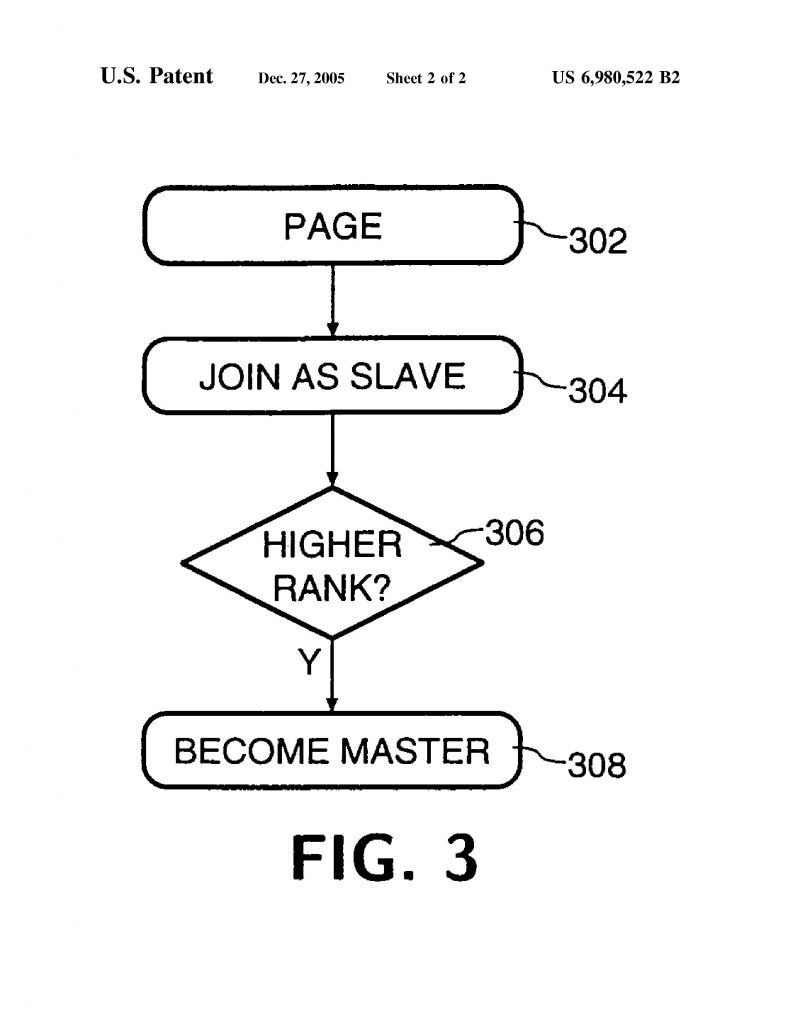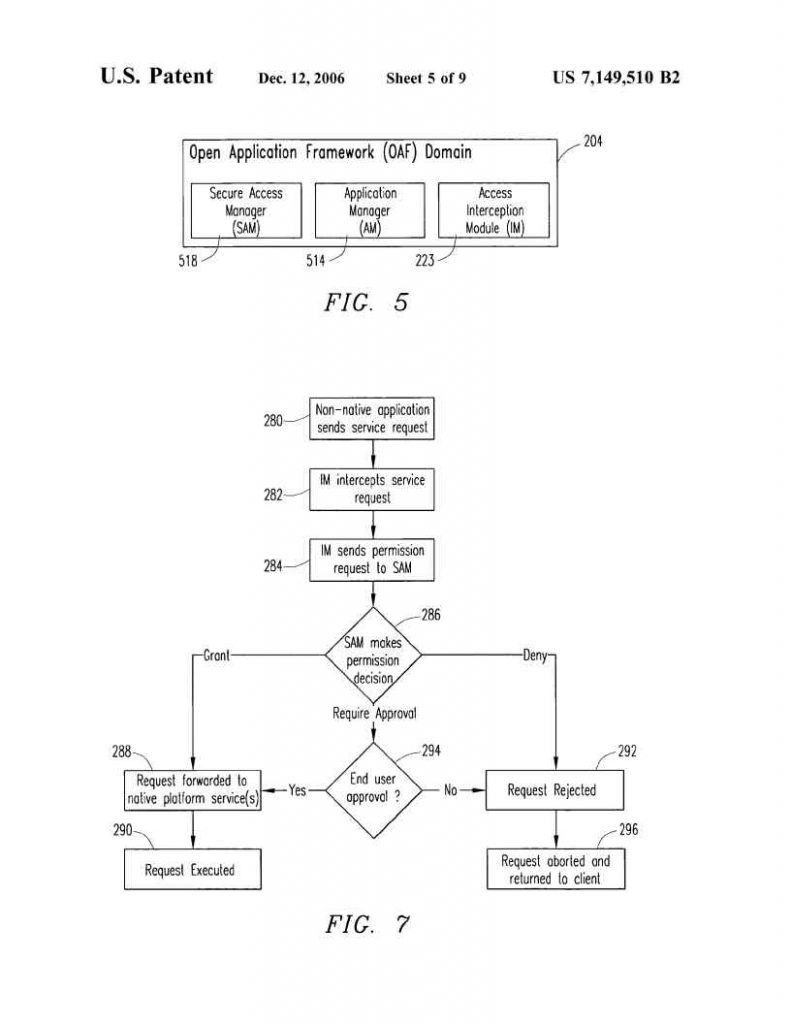
Uniloc (Uniloc 2017 LLC) appealed from a decision of the Northern District of California holding claim 6 of U.S. Patent No. 6,980,522 ineligible under 35 U.S.C. § 101.
The patent relates to a radio communication system comprising a plurality of stations capable of forming an ad-hoc network. Each station within the network is capable of acting as either a master or a slave. The specification explains that one aspect of the invention is a method of operating the system which includes ranking each of the stations based on its suitability to act as a master “and arranging for the role of master to be taken by the station having the highest rank.”
Claim 6 covers that embodiment and recites:
- A method of operating an ad-hoc radio communication system having a plurality of stations formed into at least one network, the method comprising the step of:
- determining a master/slave rank of each station in the network representative of the station’s suitability for acting as master in the network using antenna performance characteristics of each station in view of the antenna’s local environment; and enabling a station with the highest rank to be master.
Cisco moved for a dismissal on the pleadings under Rule 12(c) arguing that claim 6 of the patent is ineligible under § 101.
Alice step 1 requires a determination as to whether the claims as a whole are directed to an abstract idea. The district court held that the claims were directed to the abstract idea of “ranking stations based on antenna performance characteristics and selecting the station with the highest rank to act as master in a network.” The Federal Circuit agreed and stated that the claims are directed to the abstract idea of selecting the highest ranked station. The general recitation of the familiar concepts of ranking and selecting leaves the claimed method untethered to any specific or concrete way of implementing it.
Uniloc argued that the claim here is like others that the Federal Circuit had held eligible. The Federal Circuit did not agree. In Finjan, Inc. v. Blue Coat Systems, Inc., the Federal Circuit held that claims to a “behavior-based virus scan” provided greater computer security and were thus directed to a patent-eligible improvement in computer functionality. There, the claims required a “security profile that identifies suspicious code,” which required that the security profile “include the information about potentially hostile operations produced by a ‘behavior-based’ virus scan.” The Federal Circuit there held the claimed security profile constituted an improvement over the functionality of the traditional “code-matching” systems, which only looked for the existence of known viruses. The claims there required a specific implementation of software that improved the computer’s functionality, and were therefore not directed to an abstract idea.
Similarly in SRI International, Inc. v. Cisco Systems, Inc., the Federal Circuit held that the claims were directed to a specific improvement in computer functionality—“providing a network defense system that monitors network traffic in real-time to automatically detect large-scale attacks.” The claims specifically required use of “network monitors in the enterprise network” to detect suspicious activity, generate reports of the activity, and automatically receive and integrate those reports. The representative claim improved the technical functioning of the computer and computer networks by reciting a specific technique for improving computer network security, and was not directed to an abstract idea.
In Data Engine Techs. LLC v. Google LLC, the Federal Circuit held patent-eligible claims which recited a “specific method for navigating through three-dimensional electronic spread-sheets” thereby improving the computer’s functionality.
In Thales Visionix Inc. v. United States, the Federal Circuit held the claims were not directed to an abstract idea because they specified a particular configuration of inertial sensors and a particular method of using the raw data from the sensors in order to more accurately calculate the position and orientation of an object on a moving platform.
Unlike the claims in these cases, claim 6 of the ’522 patent broadly claims solving the problem of master stations potentially having inefficient antennas by choosing the station with the best antenna. The claim does not specify any particular metric or method for ranking. The entirety of the claim is simply the abstract idea and nothing more. Thus, the claims are directed to the abstract idea of ranking stations using their antenna performance and choosing the best station as the master.
At Alice step two, we “consider the elements of each claim both individually and ‘as an ordered combination’ to determine whether the additional elements ‘transform the nature of the claim’ into a patent-eligible application.”
The district court held that the additional claimed features were well-understood, routine and conventional, and did not provide an inventive concept that would render the claim patent eligible. The Federal Circuit agreed. As the district court recognized, “neither the claim nor the specification provides for implementation of the abstract idea using anything other than existing, conventional technology.
Uniloc admitted that the ’522 patent uses known computer hardware and wireless protocols (like Bluetooth), but argues that its claimed method uses them in a new and improved way.
The only inventive concept is forming an ad-hoc network that enables the station in the piconet with the highest rank based on antenna performance characteristics to act as master. According to the Federal Circuit, Uniloc’s only alleged inventive concept is coincident with the abstract idea itself. Thus, there are no “additional elements,” which “‘transform the nature of the claim’ into a patent-eligible application.” The Federal Circuit concluded that claim 6 of the ‘522 patent is directed to patent-ineligible subject matter and affirmed the district court.
The patentee may have had better luck if more details were recited in the claim.
 Uniloc sued LG Electronics in the United States District Court for the Northern District of California, alleging infringement of U.S. Patent No. 6,993,049. LG moved to dismiss Uniloc’s Complaint, arguing the claims of the ’049 patent are ineligible under 35 U.S.C. §101. The lower court granted LG’s motion, determining that the asserted claims are directed to an abstract idea and do not recite an inventive concept.
Uniloc sued LG Electronics in the United States District Court for the Northern District of California, alleging infringement of U.S. Patent No. 6,993,049. LG moved to dismiss Uniloc’s Complaint, arguing the claims of the ’049 patent are ineligible under 35 U.S.C. §101. The lower court granted LG’s motion, determining that the asserted claims are directed to an abstract idea and do not recite an inventive concept.